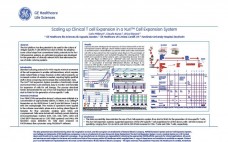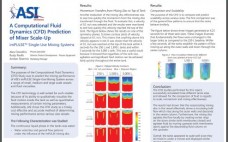During early stage drug development, quickly obtaining relevant candidate proteins through transient transfection can accelerate drug dis-covery. High titers are often obtained from Human Embryonic Kidney (HEK) 293 derived cell types; however, the use of different host cells between early stage transient and later stable protein production is a concern and can lead to the advancement of false-positive candidates. Chinese hamster ovary (CHO) cells are a desirable target cell type due to growth characteristics and a history of regulatory approval;…
Year of Publication
Development of a Novel Cold Chain Tubing, FP-FLEX™, and Single- Use Freezing Bag for Working Cell Banks Enabling Closed-System Processing to Temperatures as Low as -196°C
Working cell banks (WCB’s) are commonly applied to initiate cell culture manufacturing campaigns for production of therapeutic proteins. These campaigns typically begin with inoculation of cells previously cryopreserved in vials. While vials are typically used to establish WCB’s and initiate manufacturing campaigns, they are not optimal for the growing demands of commercial production. Vials are small and filling/removal is performed through an open cap. This process leads to numerous manual operations and culture vessels, resulting in contamination risks and potential…
Scaling Up Clinical T cell Expansion in a Xuriâ„¢ Cell Expansion System
Administration of antigen-specific T cells (ASTs), in particular for viral infections in transplantation, is one of the key focuses in immunotherapy. The Xuriâ„¢ Cell Expansion System can be used as an alternative to static cell culture methods for the stimulation and expansion of ASTs. The process described here demonstrates the use of the Xuri Cell Expansion System from the initiation of culture to the generation of virus-specific T cells. This includes a semi-static phase for antigen stimulation, a rocking phase…
Design of a New Range of High Capacity and High Flow Agarose Resins
With the continuing development of high titer cell lines, resins with very high capacity at relevant residence times are becoming increasingly important. This paper will present application and characterization data from a set of novel, agarose-based resins, with ion exchange functionality as well as with immobilized alkaline stable Protein A. The cation exchanger has a dynamic binding capacity of more than 120 mg monoclonal antibody/mL resin without the introduction of surface extenders. Performance data from an alkaline stable Protein A…
A Xeno-Free Culture System for hMSC from Various Sources Suitable for Initial Isolation and Expansion Toward Clinical Applications
Human mesenchymal stem cells (hMSC) are multipotent adult stem cells present in a variety of tissue niches in the human body. hMSC have advantages over other stem cell types due to the broad variety of their tissue sources, since they are immuno-privileged, and for their ability to specifically migrate to tumors and wounds in vivo. Due to these traits hMSC have become desirable tools in tissue engineering and cell therapy. In most clinical applications hMSC are expanded in vitro before…
A Computational Fluid Dynamics (CFD) Prediction of Mixer Scale-Up: imPULSE™ Single-Use Mixing Systems
ASI-Life Sciences commissioned a CFD study of our imPULSE single-use mixing systems to predict and characterize the mixing performance of the systems across small, medium and large vessels and fluid viscosities. One characterization from the study as you will see in Figure 1 of the poster was the rate at which the momentum from the mixing disc transferred through the fluid. As you can see in the Figure within 5 seconds, fluid motion was achieved in the 250 L, 1,500…
Adopting a Fully Single-Use Process to Improve Speed to Clinic: A Leachables Case Study
The implementation of single-use technologies for pharmaceutical product development continues to gain momentum; this trend is due to the advantages of increased flexibility, speed of implementation and lower capital investment. In particular, they are seen as a means to accelerate the production of material for clinical trials. However, a primary concern regarding the use of such technologies is the impact and level of leachables in the final drug substance. Typically this concern is addressed through a risk assessment utilizing extractable…
Freeze-Pak™ STS Bio-Containers and STS Shippers: A New Single-Use Solution for Frozen Storage & Transport to -80°C
Frozen storage is commonly performed and enables manufacturing process flexibility, long-term product stability and minimizes logistics challenges. While single-use containers are available for storage and transport of frozen products, some require a significant investment while others don’t offer the necessary support and protection. Using films and bags not designed for frozen storage applications can be detrimental.  Charter Medical recently developed a new family of single-use frozen storage and transport solutions. The Freeze-Pakâ„¢ STS (FP-STS) bio-containers and supporting secondary single-use…
Optimization of HEK 293 and CHO-S Cell Growth by Supplementation of Non-Animal Derived Components Using Design of Experiments (DoE)
Mammalian cells are a widely used expression platform for the production of recombinant therapeutic proteins or viral particle-based vaccines since they typically perform appropriate protein post-translational modifications and authentic viral particle assembly. Of the available mammalian cells, CHO and HEK 293 are some of the most industrially relevant cell lines because they are cGMP compliant and are able to grow in suspension in a variety of serum-free media. Of note, production of human therapeutics in mammalian cell culture has become…
Purification of Clinical Grade MAb using Hydrophobic Cation Exchange Chromatography Resin
A three-step non-rProtein A capture process shows how the selectivity afforded by Nuvia cPrime resin can be used to clear a light chain contaminant that has a homologous sequence and similar pI to the target MAb monomer. The unique balance between the hydrophobic and charged character of Nuvia cPrime allows for a compact process with reduced buffer consumption and feed conditioning.










